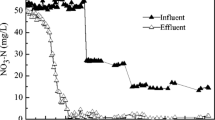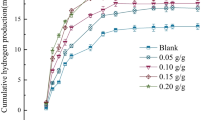Abstract
Poly(aspartic acid-itaconic acid) copolymers (PAI) is a new scale inhibitor for water treatment. Thus, it is necessary to investigate its biodegradability. The biodegradability of PAI was investigated through CO2 evolution tests under different conditions based on determination of carbon dioxide production. The investigation results showed that the degradation rate of PAI on day 10 and day 28 were respectively 38.7 and 79.5%, indicating that PAI was one kind of easily biodegradable scale inhibitors. With the increase in the content of itaconic acid in copolymerization process, the biodegradability of PAI was significantly reduced. In addition, the high biodegradability might be attributed to the existence of C–N bone-structure and more –COO–. Finally, Cu2+ could decrease the degradation percentage and the enzyme inhibition effect of Cu2+ was not the linear effect, but the “low-dosage effect”.







Similar content being viewed by others
References
Xu Y, Zhang B, Zhao LL et al (2013) Synthesis of polyaspartic acid/5-aminoorotic acid graft copolymer and evaluation of its scale inhibition and corrosion inhibition performance. Desalination 311:156–161
Chaussemier M, Pourmohtasham E, Gelus D et al (2015) State of art of natural inhibitors of calcium carbonate scaling. A review article. Desalination 356:47–55
Guo RH, Yan MF, Liu ZF (2010) Corrosion inhibition capacity and biodegradability of polyaspartic acid graft copolymers containing hydroxyl. Ind Water Treat 30(5):36–37
Popuri SR, Hall C, Wang CC et al (2014) Development of green/biodegradable polymers for water scaling applications. Int Biodeterior Biodegrad 95:225–231
Gu XX, Qiu FX, Zhou X et al (2013) Preparation and application of polymers as inhibitors for calcium carbonate and calcium phosphate scales. Int J Polym Mater 62(6):323–329
Tao HC, Huang JL, Yang SL et al (2004) Researches on biodegradability of polyaspartic acid in aqueous medium. J Harbin Inst Technol 36(12):1659–1662
OECD (1992) CO2 evolution test. OECD Guideline for testing of chemicals 301B
Yeh JC, Yang HH, Hsu YT et al (2013) Synthesis and characteristics of biodegradable and temperature responsive polymeric micelles based on poly(aspartic acid)-g-poly(N-isopropylacrylamide-co-N, N-dimethylacrylamide). Colloids Surf A 421(11):1–8
Sun XY, Zhang JP, Yin CX et al (2015) Poly(aspartic acid)–tryptophan grafted copolymer and its scale-inhibition performance. J Appl Polym Sci 132(45):
OECD (1992) OECD Guideline for testing of chemicals 301B
Chen W, Li SP, Li TD (2009) Calcium carbonate inhibition by a phosphonate-terminated poly(maleic-co-sulfonate) polymeric inhibitor. Desalination 249(1):1–4
Han W, Wang B, Liu X et al (2012) Fermentative hydrogen production from molasses in an activated sludge immobilized bioreactor. Int J Energy Eng
Roweton S, Huang SJ, Swift G (1997) Poly(aspartic acid): synthesis, biodegradation, and current applications. J Environ Polym Degr 5(3):175–181
Huang JL, Cheng ZH, Zhang YL et al (2007) Study on biodegradability of copolymer of aspartic acid and glutamic acid. J Harbin Inst Technol 39(8):1230–1232
Zhu D, Guo J, Yang P et al (2014) Synthesis and characterization of polyaspartic acid–glutamic acid grafted copolymers and their performances as detergent builder. J Appl Polym Sci 131(10):376–418
Acknowledgements
This work was financially supported by National Natural Science Foundation of China (Grant No. 51308211), Natural Science Foundation of Hebei Province (Grant No. E2016502097) and the Fundamental Research Funds for the Central Universities (Grant No. 2015MS63).
Author information
Authors and Affiliations
Corresponding author
Rights and permissions
About this article
Cite this article
Zhang, Y., Wei, H., Jiang, Y. et al. Biodegradation of Poly(Aspartic Acid-Itaconic Acid) Copolymers by Miscellaneous Microbes from Natural Water. J Polym Environ 26, 116–121 (2018). https://doi.org/10.1007/s10924-016-0923-z
Published:
Issue Date:
DOI: https://doi.org/10.1007/s10924-016-0923-z




